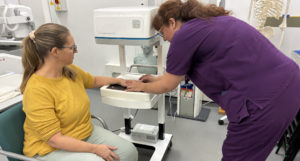Genetics study leads to largescale diabetes clinical trial launch in Chinese hospitals

Scientists have refined a new way of using genetics to identify whether someone has type 1 or type 2 diabetes in Chinese populations – and it is now being used in a large clinical trial to improve treatment in the region.
Up to 40 per cent of people with adult-onset type 1 diabetes are initially diagnosed with type 2. This can mean delays in getting the insulin they need, which can result in complications. This misdiagnosis is a particular issue in China, where many patients do not fit the classic age or weight profile of the diabetes with which they are diagnosed.
Until now, diabetes classification in East Asian patients has been based on the symptoms with which the patients present and conventional tests. Current methods of early diagnosis involve measuring islet autoantibodies—proteins in the blood which indicate evidence of beta cell destruction. However, around 25 per cent of individuals with newly diagnosed type 1 diabetes lack detectable islet autoantibodies.
The study is published in the journal Diabetologia. The work included a total of more than 2,000 Chinese patients with type 1 diabetes, 1,000 with type 2 diabetes, and 3,000 controls, across different parts of the study. Researchers at China’s Second Xiangya Hospital developed information from a previous genetic risk score and methods pioneered by researchers at the University of Exeter. The new research analysed all the genetic factors involved in diabetes among the participants, to create a Chinese-specific version of the genetic risk score – a test that aids in diagnosis.
In conducting the study, researchers identified possible new genetic risk factors for type 1 diabetes, that may be more prominent among the Chinese. This work was funded by the National Key Research and Development Program of China and the Noncommunicable Chronic Diseases-National Science and Technology Major Project of China, whilst additional research work in Hong Kong was supported by the Hong Kong Research Grants Council Theme-based Research Scheme, the Research Impact Fund and Research Grants Matching Scheme.
Professor Richard Oram, of the University of Exeter, who has been refining genetic risk scores for type 1 diabetes for ten years, said: “A lot of our knowledge of type 1 diabetes has been generated from studies of Europeans and does not apply to people from other regions around the world. This study will directly benefit the potentially millions of people with diabetes in East Asia who may be misdiagnosed, and will also help predict and classify type 1 diabetes more accurately across the globe.”
Professor Zhiguang Zhou, at the Second Xiangya Hospital of Central South University, said: “We are delighted that this collaboration has significantly advanced our understanding of the genetic basis of type 1 diabetes in the Chinese population. By identifying the genetic factors most strongly linked to type 1 diabetes in Chinese, our work has improved the prediction and classification of diabetes in Chinese.”
Now, researchers at the National Clinical Research Centre for Metabolic Diseases, the Second Xiangya Hospital of Central South University are recruiting up to 3,000 people across 80 hospitals in China who are newly diagnosed with diabetes. The study will assess whether the use of the Chinese-specific genetic risk score can identify people with type 1 diabetes at diagnosis, who will likely need insulin treatment.
Diabetes affects the way the body regulates blood sugar levels. Type 1 diabetes develops when the body’s own immune system attacks insulin-producing beta cells in the pancreas, which means people need to inject insulin daily. Type 2 diabetes can be triggered by high BMI and affects either the body’s ability to produce enough insulin or the way the body responds to normal insulin levels. A number of treatments are available for type 2 diabetes, and nearly half of patients with a short disease duration may achieve diabetes remission following treatment.
Professor Yang Xiao, at Second Xiangya Hospital of Central South University, which is leading the clinical trial, said: “We are really excited to lead this pioneering trial, which will assess the use of this new test in clinical care. We hope that this will help people get the treatment they need much faster, avoiding potentially life-threatening complications. If successful we hope that this could be rolled out across China.”
The identified genetic factors for type 1 diabetes in Chinese people were replicated and shown to also identify the risk of type 1 diabetes in a separate group of patients in Hong Kong, after analysis by researchers from The Chinese University of Hong Kong. When applied to different patient groups, the test was found to improve the ability to correctly identify the type of diabetes in Chinese individuals with the disease. This meant that approximately an additional 20-40 of every 100 people presenting with type 1 diabetes would get the right diagnosis. The test could also be used to identify those who are most likely to develop type 1 diabetes in the future. This is particularly useful for people at high risk, for example where family members already have type 1 diabetes. In the UK, a test is already available to buy for this purpose.
Professor Ronald Ma, at The Chinese University of Hong Kong, said: “It is very hard to tell from symptoms alone whether someone has type 1 or type 2 diabetes, but getting the right diagnosis makes a big difference to their treatment, and blood sugar control. This new test may be a real step forward in getting the right diabetes diagnosis the first time.”
The paper is titled ‘A type 1 diabetes genetic risk score discriminates between type 1 diabetes and type 2 diabetes in a Chinese population’, and is published in Diabetologia.



